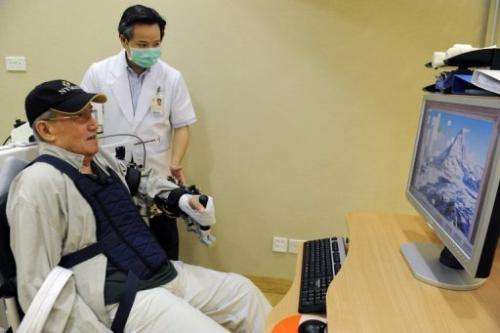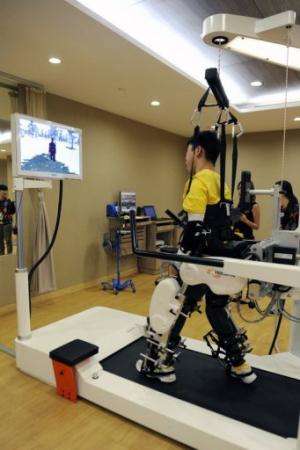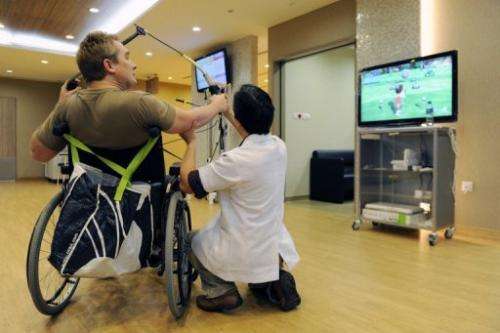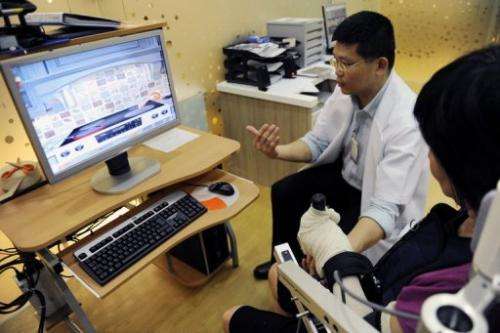Greying Singapore taps robots, games in rehab

Six months ago, Singaporean retiree Soon Eng Sam, 70, suffered a stroke that paralysed the left side of his body.
Bedridden for three months, he has regained some limb functions on the affected side through conventional physical therapy but now hopes to hasten his recovery with the help of new gadgets designed to make rehabilitation fun.
"This therapy is not so boring, not so painful as physical therapy, because the machine is assisting me to move my arm up and down and laterally," he said after a recent hour-long session with the "Armeo" robotic arm.
A therapist had to tell Soon to slow down as the former civil servant enthusiastically used his left hand, partly supported by the robotic arm, to catch virtual water droplets with a teacup on a colour monitor.
The machine is among the high-tech exercise stations now being used at the Centre for Advanced Rehabilitation Therapeutics (CART), described by its administrators as the most advanced facility of its kind in Asia.
Medical authorities are deploying the latest technology as fast-greying Singapore prepares for a "silver tsunami" of elderly people as a result of longer life spans and low birth rates.

In two decades, an estimated 20 percent of the population will be 65 years or older, compared to 9.3 percent at present.
To better prepare themselves for the demographic explosion, hospitals in the affluent city-state of five million people are using the latest available technology to augment its limited pool of health personnel.
Chan Kay Fei, head of Rehabilitation Medicine at the government-run Tan Tock Seng Hospital, which houses CART, said therapists on their own "cannot meet this rising need of the ageing population".
"So technology, I feel, could be the multiplier," Chan said, adding that both therapists and patients benefit from the increasing use of robotic equipment and videogame-inspired software.
"Robotics reduce or eliminate physical loading upon our therapists. It creates an interesting and interactive environment which offers consistency and objectivity to the treatment programme," he said.

Using the machines, therapists are able to precisely monitor the patient's progress and calibrate the machines accordingly.
The "Lokomat" gait trainer shows a movie-like avatar, controlled by the patient's movements, walking around a virtual world collecting medals.
Such machines are particularly suited for countries with rapidly ageing populations, said Bala Rajaratnam, a lecturer at the School of Health Sciences at Nanyang Polytechnic.
"It allows therapists to use smart technology to both empower clients to take control over their recovery as well as maximise therapy time," he said.
Future physical therapists at Bala's school also use videogame machines such as the Nintendo Wii to help patients recover more quickly than they would using conventional methods.

Other medical institutions in Singapore such as KK Women's and Children's Hospital as well as Changi General Hospital are also using videogames as part of their repertoire of therapy.
"The targeted patient population includes people with neurological conditions such as stroke, acquired brain injury and Parkinson's Disease," said Jean Tan, a senior physiotherapist at Changi.
"Any patients with balance deficits and decreased arm function will also benefit from these games."
Younger patients, including accident victims and those with congenital motor problems, also benefit from therapy robots and videogames.
Kankipati Rajan Raju, 45, an Indian banker who was paralysed from the neck down after being hit by a bus during a business trip to France in May, said technology is a boon to people like him but the human factor is still more crucial than machines.
Six months after the accident, Raju can walk on his own, shake hands and even do short jumps, a "miracle" he attributes to medical personnel as well as a healthy dose of robotics and virtual reality.
"The technology assists you, but the therapists have made the difference," he said after a session at CART.
(c) 2012 AFP















